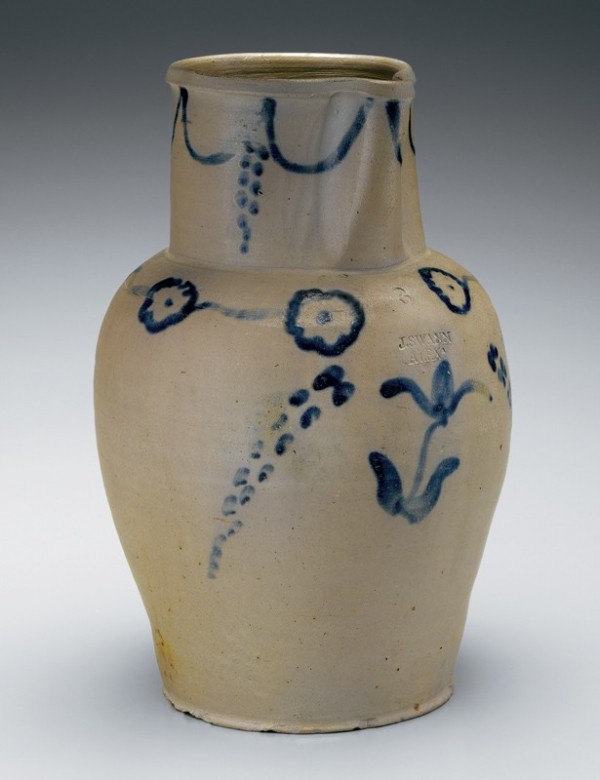
Pitcher, Alexandria, Virginia, 1819–1821. Salt-glazed stoneware. H. 15". Impressed “J.SWANN / ALEXA.” (Courtesy, The Lyceum: Alexandria’s History Museum. Unless otherwise noted, all photos by Gavin Ashworth.)
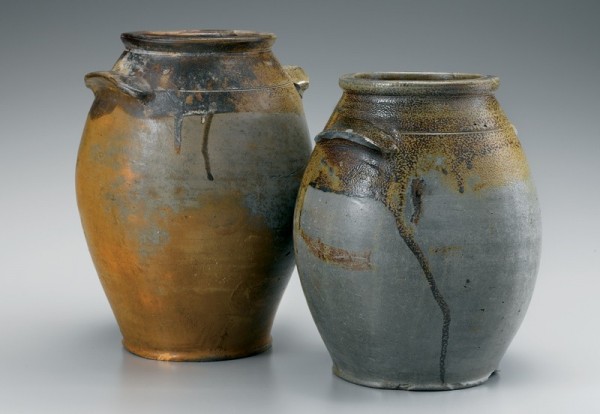
Jars, attributed to John Swann, Alexandria, Virginia, 1810–1819. Salt-glazed stoneware. Left: H. 11". (Courtesy, Alexandria Archaeology Museum.) Right: H. 9". (Courtesy, Smithsonian Institution, National Museum of American History.) The bulbous shape and brown neck and shoulder of both jars are similar to Swann’s jugs, and the rim forms match fragments of similar wares from the kiln site at the Wilkes Street Pottery. The shape is continued in Swann’s later cobalt-decorated jars. Archaeologists found the jar (left) in a privy on a residential site at 104 South Saint Asaph Street in Alexandria.

Impressed capacity mark, attributed to John Swann, 1810–1819. (Courtesy, Alexandria Archaeology Museum.) A round capacity mark with coggled border was found on a few pieces of Swann’s early stoneware, as well as on some post-1847 wares marked “B.C. MILBURN / ALEXA.” The reversed “3” on this fragment from a 3-gallon Swann jug from the Wilkes Street Pottery site is unusual.
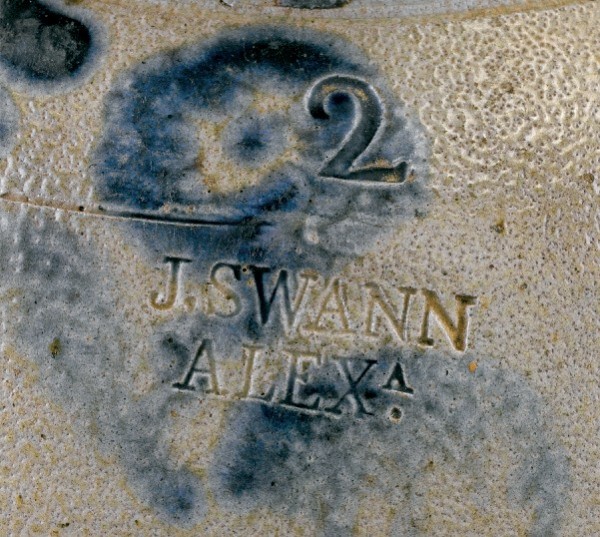
Detail of the pitcher illustrated in fig. 16, showing impressed potter’s mark: “J.SWANN / ALEXA.” Stamped in 24-point type. This stamp was found on a plain jug as well as on cobalt-decorated vessels.
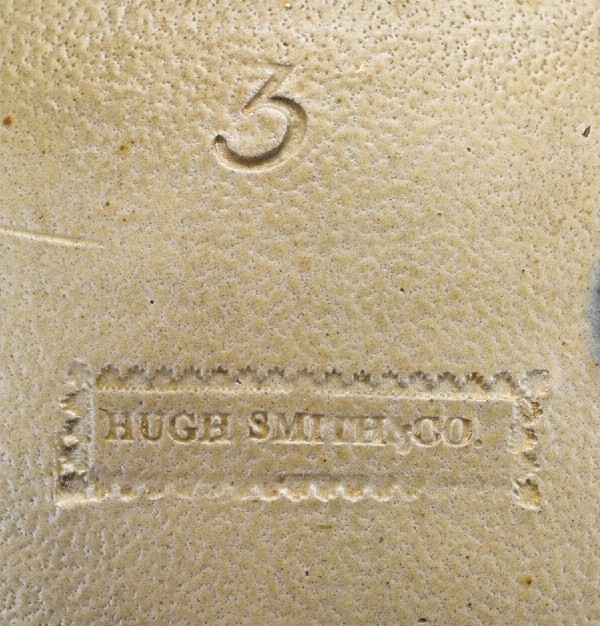
Detail of the pitcher illustrated in fig. 26, showing impressed merchant’s mark: “HUGH SMITH & CO.” Stamped in 12-point type, this is the only Alexandria mark that employs a frame. Swann appears to have used this merchant mark starting in 1821, when he entered into an agreement by which Smith purchased all of his stoneware.

Detail of the pitcher illustrated in fig. 29, showing impressed merchant’s mark: “H.SMITH & CO.” Stamped in 26-point type. This mark appears on forty-two sherds from the kiln site, including cobalt-decorated pitchers, cake pots, churns, jars, milk pans, and plain jugs.

Jugs, attributed to John Swann, Alexandria, Virginia, 1810–1819. Salt-glazed stoneware. H. (left to right) 15", 12", and 15". (Courtesy, Alexandria Archaeology Museum.) The bulbous shape, ringed neck, and iron wash dipped to the shoulder and dripping down the vessel are all characteristics of Swann’s earliest pottery. The piece at right is a waster from the kiln site; the others were recovered from privies in downtown Alexandria.
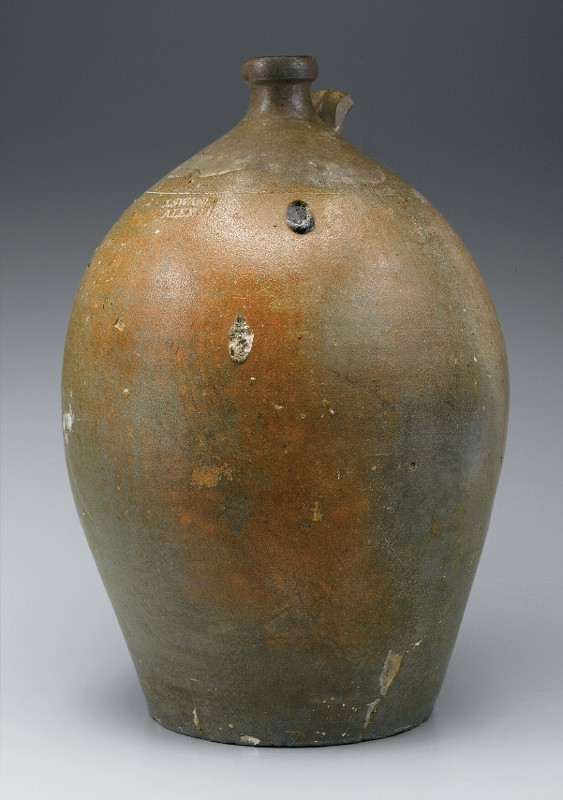
Jug, Alexandria, Virginia, 1819–1821. Salt-glazed stoneware. H. 16". Impressed “J.SWANN / ALEXA.” (Courtesy, The Lyceum: Alexandria’s History Museum.) The simpler neck form, absence of dipped iron oxide, and impressed mark all indicate a later date than for the objects illustrated in fig. 7. Examples of this neck form were also found at the kiln site.
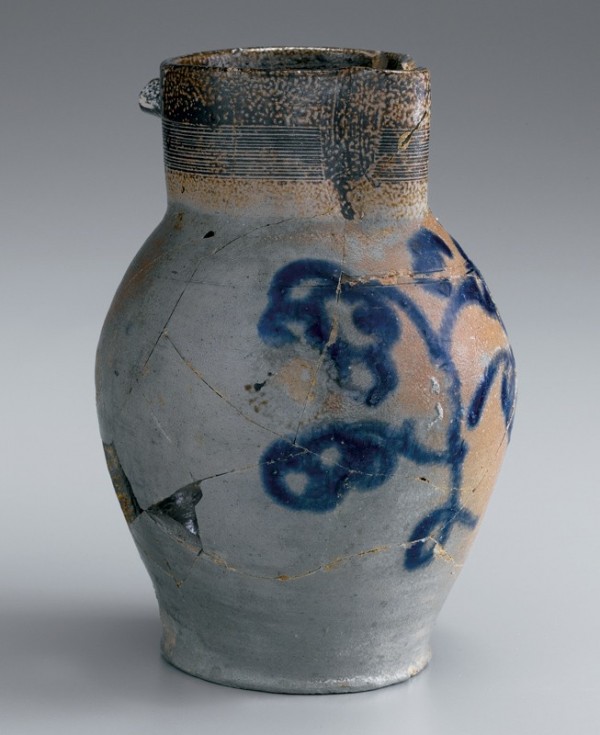
Pitcher, attributed to John Swann, Alexandria, Virginia, 1819–1821. Salt-glazed stoneware. H. 8 3/4". (Courtesy, Alexandria Archaeology Museum.) This transitional piece, which combines Swann’s earlier brown wash with cobalt decoration, was recovered by archaeologists from excavations in a privy behind the historic Gadsby’s Tavern Museum.
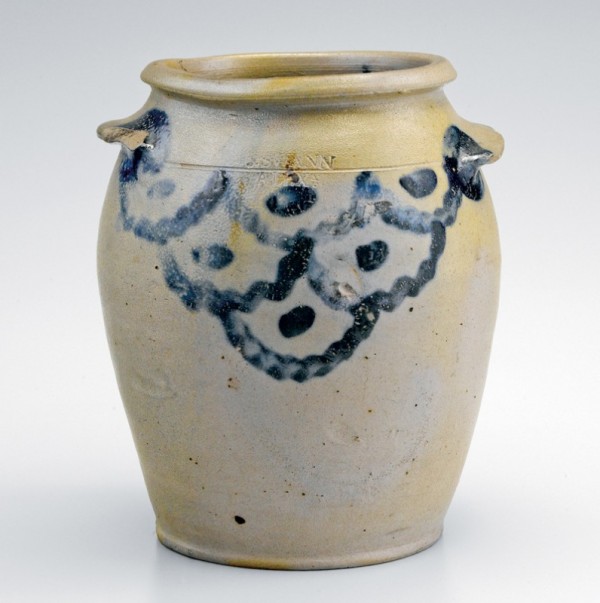
Jar, Alexandria, Virginia, 1819–1821. Salt-glazed stoneware. H. 9 1/2". Capacity: 1 gallon. Impressed “J.SWANN / ALEXA.” (Private collection.) Abstract designs such as this fish-scale pattern are less common than flowers on Alexandria stoneware.
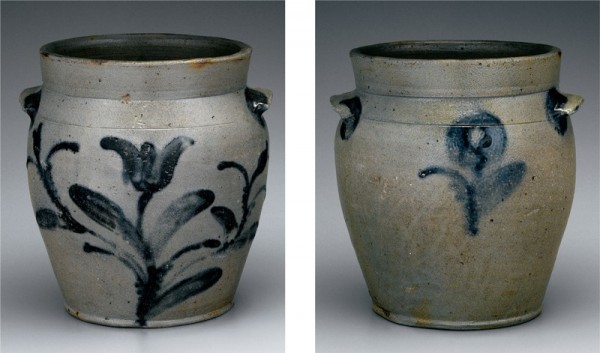
Jar, Alexandria, Virginia, 1819–1821. Salt-glazed stoneware. H. 10 1/2". Capacity: 1 1/2 gallons. Impressed “J.SWANN / ALEXA.” (Courtesy, John and Lil Palmer.) The three-petal tulip on the front (left) and the stylized round sunflower on the back (right) are the most common flowers depicted on Alexandria stoneware, although they rarely appear on the same vessel.

Churn, Alexandria, Virginia, 1819–1821. Salt-glazed stoneware. H. to neck 12". Capacity: 2 gallons. Impressed “J.SWANN / ALEXA.” (Courtesy, The Lyceum: Alexandria’s History Museum.) The floral decoration extends to the back of the churn.

Milk pan, Alexandria, Virginia, 1819–1821. Salt-glazed stoneware. D. 8 1/4". Impressed “J.SWANN / ALEXA.” (Courtesy, Alexandria Archaeology Museum.) The sparse decoration, representing pairs of leaves, is repeated on the reverse. This vessel was found in a privy at 104 South Saint Asaph Street, along with the stoneware illustrated in figs. 19 and 29.
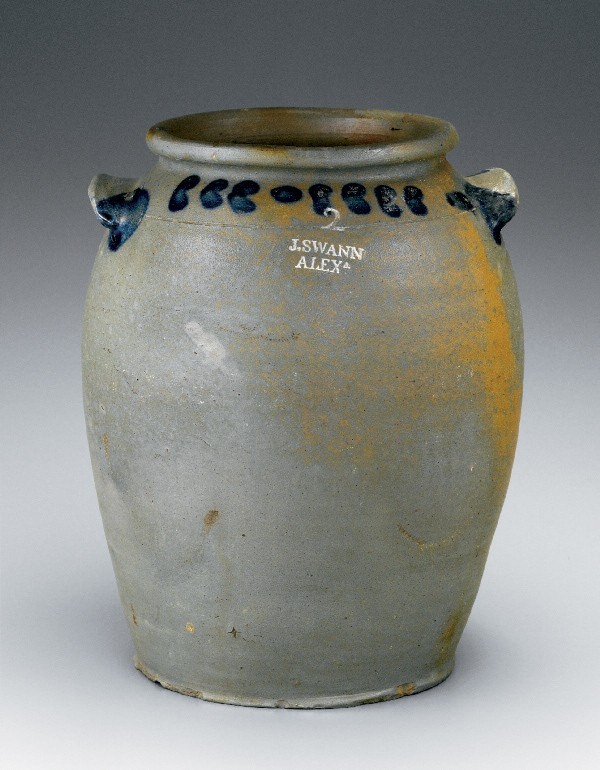
Jar, Alexandria, Virginia, 1819–1821. Salt-glazed stoneware. H. 12". Capacity: 2 gallons. Impressed “J.SWANN / ALEXA.” (Courtesy, Alan Darby.) Paired leaves made with small dabs of color are typical of Swann’s decoration. The design is repeated on the reverse.
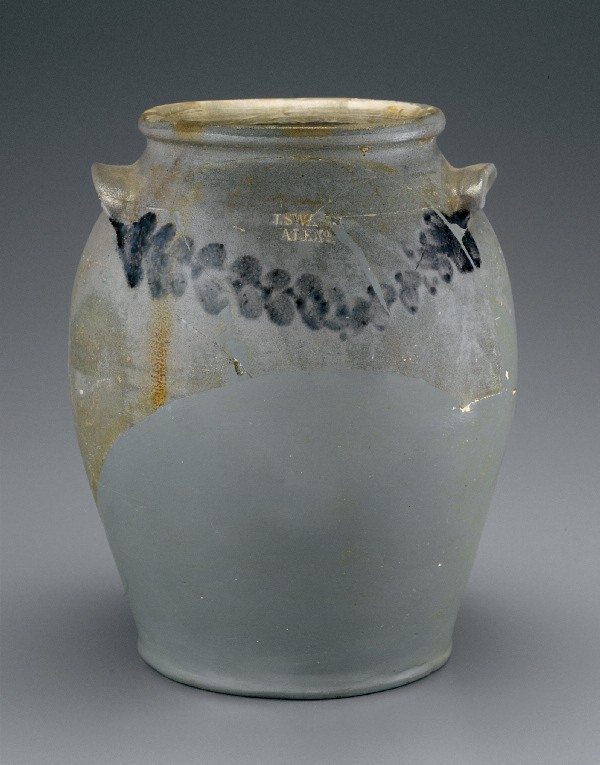
Jar, Alexandria, Virginia, 1819–1821. Salt-glazed stoneware. H. 13". Impressed “J.SWANN / ALEXA.” (Courtesy, Alexandria Archaeology Museum.) Paired leaves made with small dabs of color are typical of Swann’s decoration. The design is repeated on the reverse. The jar was found in a privy on the 100 block of South Royal Street.
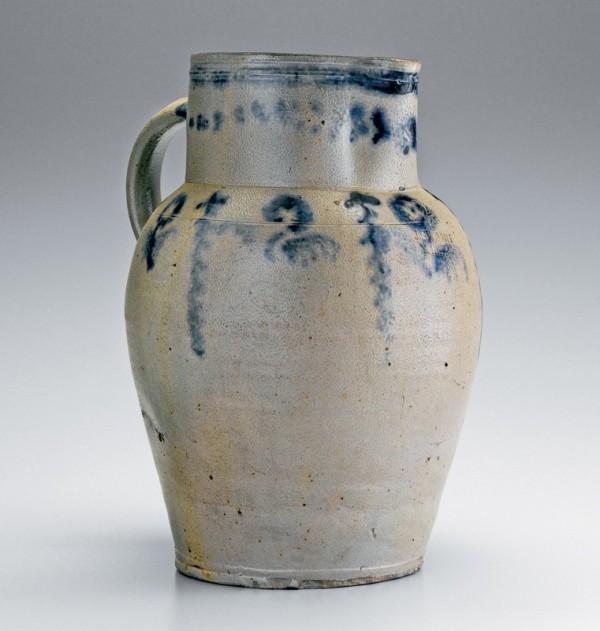
Pitcher, Alexandria, Virginia, 1819–1821. Salt-glazed stoneware. H. 13 1/4". Capacity: 2 gallons. Impressed “J.SWANN / ALEXA.” (Private collection.) This elaborate pitcher combines simple paired leaves with a repeated floral motif.
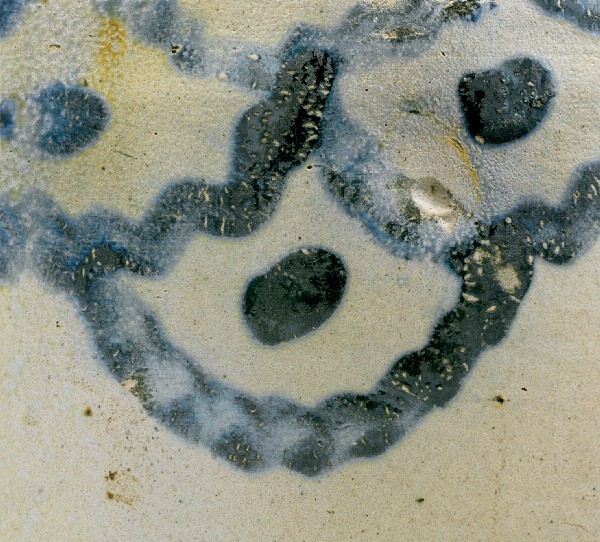
Detail of the decoration on the jar illustrated in fig. 10. As on many of Swann’s pieces, the design is composed of small dabs of color.

Jar, Alexandria, Virginia, 1819–1821. Salt-glazed stoneware. H. 8 3/4". Impressed “J.SWANN / ALEXA.” (Private collection.) Variations of this round flower are used throughout the history of the Wilkes Street Pottery. On this early example, the flowers are made up of short brushstrokes.
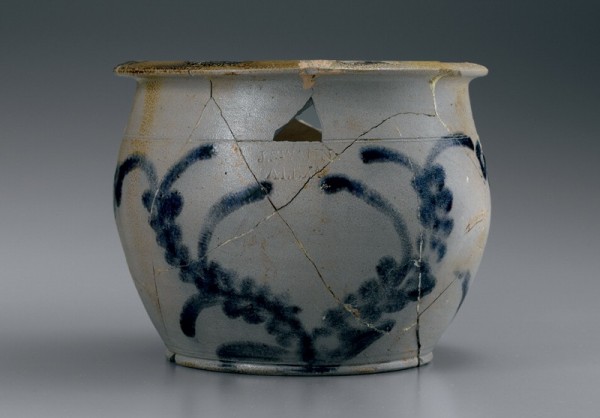
Chamber pot, Alexandria, Virginia, 1819–1821. Salt-glazed stoneware. D. 8 1/4". Impressed “J.SWANN / ALEXA.” (Courtesy, Alexandria Archaeology Museum.) Short dabs of color combine with longer brushstrokes in this leafy design. The chamber pot was found in a privy at 104 South Saint Asaph Street.
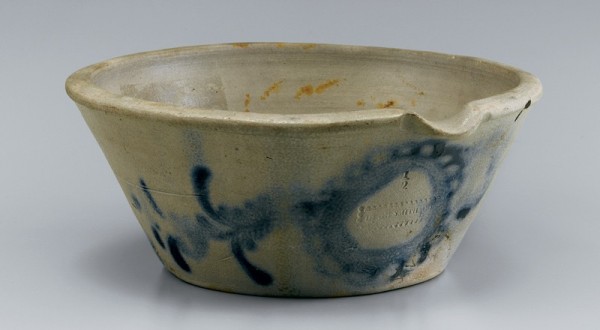
Milk pan, Alexandria, Virginia, 1821–1825. Salt-glazed stoneware. D. 9 1/2". Capacity: 1/2 gallon. Impressed “HUGH SMITH & CO.” (Courtesy, The Lyceum: Alexandria’s History Museum.) The flower is flanked by branches of long and short leaves, similar to those on the chamber pot illustrated in fig. 19.
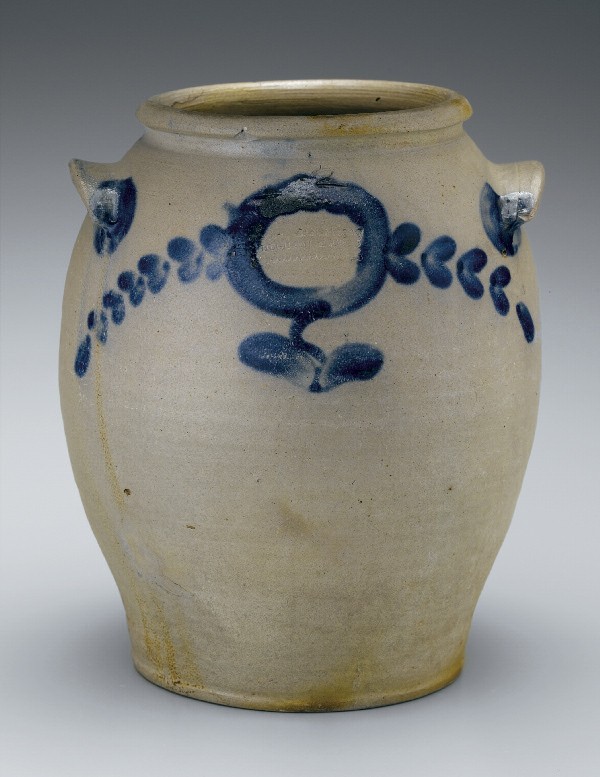
Jar, Alexandria, Virginia, 1821–1825. Salt-glazed stoneware. H. 11". Capacity: 2 gallons. Impressed “HUGH SMITH & CO.” (Courtesy, The Lyceum: Alexandria’s History Museum.) Similar decoration appears on vessels with the later mark “H. SMITH & CO.” A simple sprig of three leaves appears on the reverse.
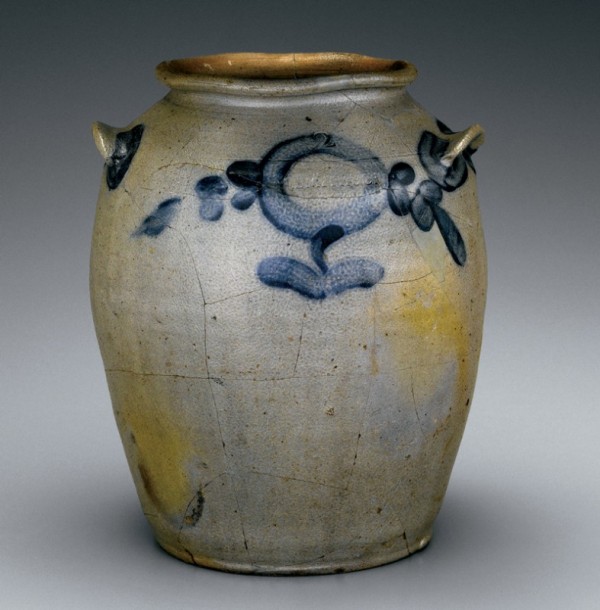
Jar, Alexandria, Virginia, 1825–1831. Salt-glazed stoneware. H. 11". Capacity: 2 gallons. Impressed “H.SMITH & CO.” (Courtesy, Al Marzorini.)

Jar, Alexandria, Virginia, 1825–1831. Salt-glazed stoneware. H. 10 1/4". Capacity: 1 gallon. Impressed “H.SMITH & CO.” (Courtesy, Donald Jenkins.)
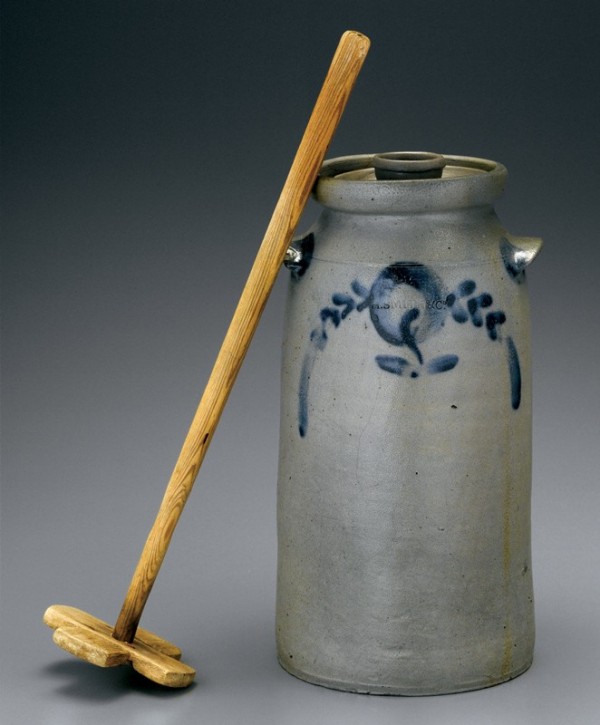
Churn, Alexandria, Virginia, 1825–1831. Salt-glazed stoneware. H. 14 3/4". Impressed “H.SMITH & CO.” (Courtesy, John and Lil Palmer.) On the reverse is a five-leaf sprig. The wooden dasher and stoneware lid/dasher guide may not be original.

Jar, Alexandria, Virginia, 1819–1821. Salt-glazed stoneware. H. 12". Capacity: 2 gallons. Impressed “J.SWANN / ALEXA.” (Courtesy, Alan Darby.) Small foliate sprigs of three or five leaves are found on the reverse of many early Swann vessels. The front of this jar is decorated with a border of paired leaves at the neck (see fig. 14).
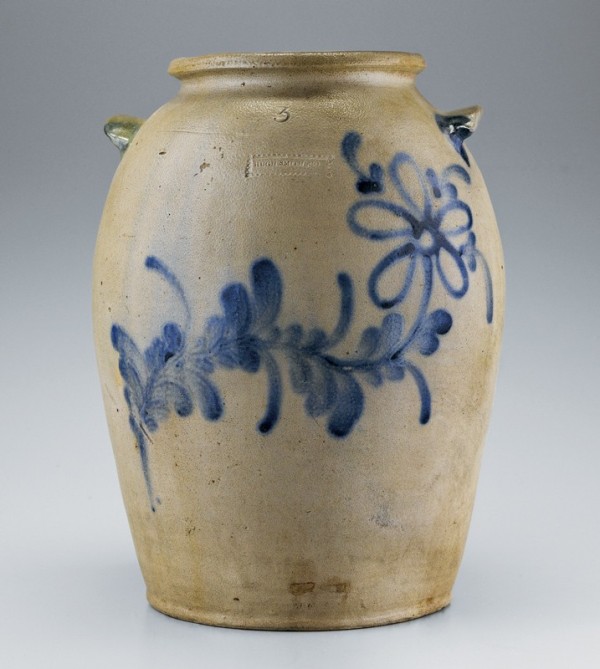
Jar, Alexandria, Virginia, 1821–1825. Salt-glazed stoneware. H. 14 1/2". Capacity: 3 gallons. Impressed “HUGH SMITH & CO.” (Private collection.) This jar is one of the most elaborate with Hugh Smith’s mark, and a precursor to later vessels with foliage extending across the front of the vessel. The narrow contours of the flower petals reflect Milburn’s later use of the slip-trailing technique.

Jar, Alexandria, Virginia, 1825–1831. Salt-glazed stoneware. H. 13 1/2". Capacity: 3 gallons. Impressed “H.SMITH & CO.” (Courtesy, John and Lil Palmer.) The round-flower design becomes more elaborate during this period. Banded rims, on both ovoid and cylindrical jars, appear rarely.
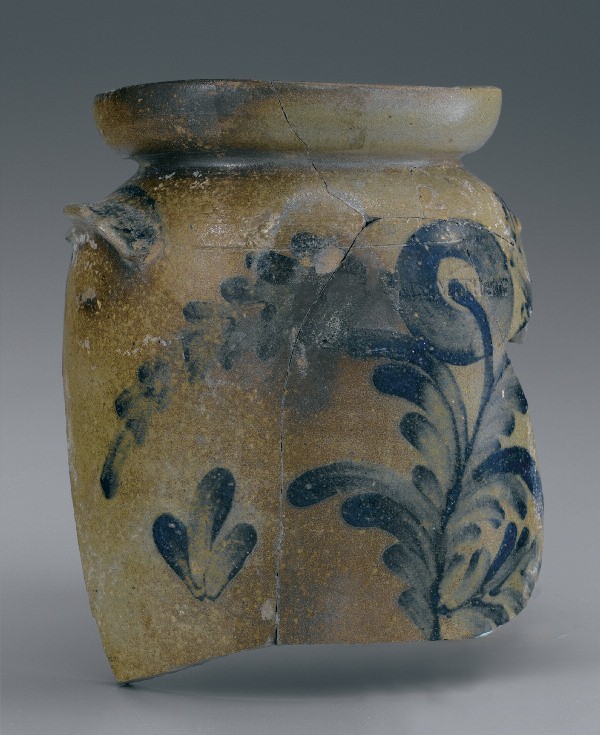
Churn fragment, Alexandria, Virginia, 1825–1831. Salt-glazed stoneware. D. of rim 6". Capacity: 2 gallons. Impressed “H.SMITH & CO.” (Courtesy, Alexandria Archaeology Museum.) This fragment was found at the kiln site. New potters or decorators employed by the Smith Company in the late 1820s began to make vessels with more exuberant decoration, such as this one.

Cake pot, Alexandria, Virginia, 1825–1831. Salt-glazed stoneware. D. 9 1/2". Capacity: 1 gallon. Impressed “H.SMITH & CO.” (Courtesy, Alexandria Archaeology Museum.) This is a fine example of the central-flower design known as the Alexandria Motif. Decoration during this period reached a new level of sophistication, with the addition of leaves and a more complicated design. This pot was found in a privy at 104 South Saint Asaph Street.

Jar (reverse of the jar illustrated in fig. 37), Alexandria, Virginia, 1825–1831. Salt-glazed stoneware. H. 14 3/4". Capacity: 3 gallons. Impressed “H.SMITH & CO.” (Private collection.) A wavelike design first appears on vessels with this mark.
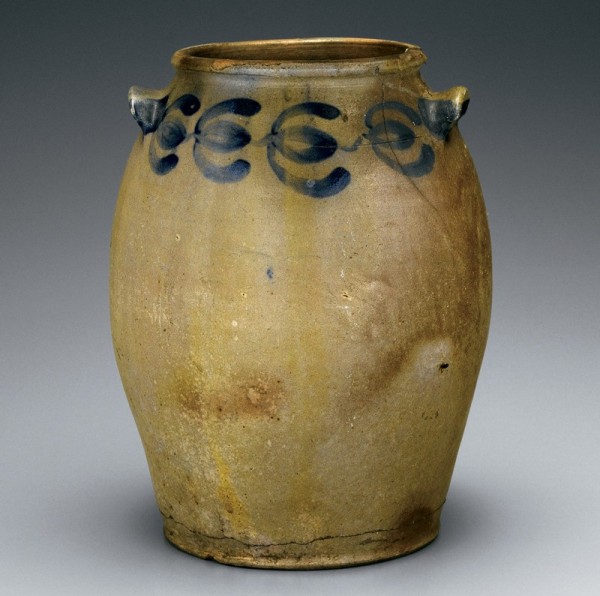
Jar (reverse of the jar illustrated in fig. 34), Alexandria, Virginia, 1825–1831. Salt-glazed stoneware. H. 14 3/4". Capacity: 2 gallons. Impressed “H.SMITH & CO.” (Courtesy, Al Marzorini.) A three-petal tulip rotated 90 degrees, as seen on this jar, marks another new design element on the reverse of vessels.

Jar, Alexandria, Virginia, 1825–1831. Salt-glazed stoneware. H. 10". Capacity: 1 gallon. Impressed “H.SMITH & CO.” (Courtesy, Alexandria Archaeology Museum.) The well-executed brushstrokes and graduated, curving leaves are typical of the more exuberant style found on vessels with this mark. The chainlike design on the shoulder continues on the reverse. This jar was found in excavations of a privy at 112 South Fairfax Street.
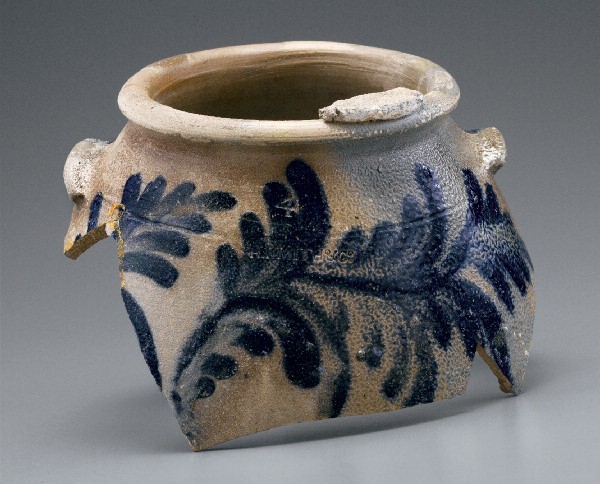
Jar fragment, Alexandria, Virginia, 1825–1831. Salt-glazed stoneware. D. of rim 7 1/4". Capacity: 4 gallons. Impressed “H.SMITH & CO.” (Courtesy, Alexandria Archaeology Museum.) Vines sometimes encircle an entire vessel or, as on this example, appear just on the front. A five-leaf cluster is on the reverse of this waster from the kiln site. A piece of kiln furniture, used to separate vessels during firing, adheres to the rim.

Jar, Alexandria, Virginia, 1825–1831. Salt-glazed stoneware. H. 12 3/4". Capacity: 2 gallons. Impressed “H.SMITH & CO.” (Courtesy, Al Marzorini.) The encircling flowers and foliage appear in mirror image above and below a nearly straight line, in an arrangement that continued to be used on vessels with later marks.

Jar, Alexandria, Virginia, 1826–1831. Salt-glazed stoneware. H. 22". Capacity: 10 gallons. Impressed “H.SMITH & CO.” (Private collection.) This is one of the most elaborately decorated pots from Wilkes Street. The straight central stem with leafy branches that extend at a 45-degree angle from the base is found only on a signed Jarbour pot (fig. 42) and on jars and churns with the “H.SMITH & CO.” mark. The reverse is completely covered in three-leaf sprigs, with a tulip-like flower at the top.

Jar, Alexandria, Virginia, 1825–1831. Salt-glazed stoneware. H. 13". Capacity: 2 gallons. Impressed “H.SMITH & CO.” (Courtesy, William and Jane Yeingst.) This jar combines diagonally arranged branches with a chain border. Chains first appear on the more elaborately decorated vessels of this period and commonly appear on later Milburn vessels.

Jar, Alexandria, Virginia, 1826–1831. Salt-glazed stoneware. H. 14 3/4". Capacity: 3 gallons. Impressed “H.SMITH & CO.” (Private collection.) In a much simpler version of the Jarbour style, a central flower is again combined with branches extending at 45-degree angles from the base of the stem.
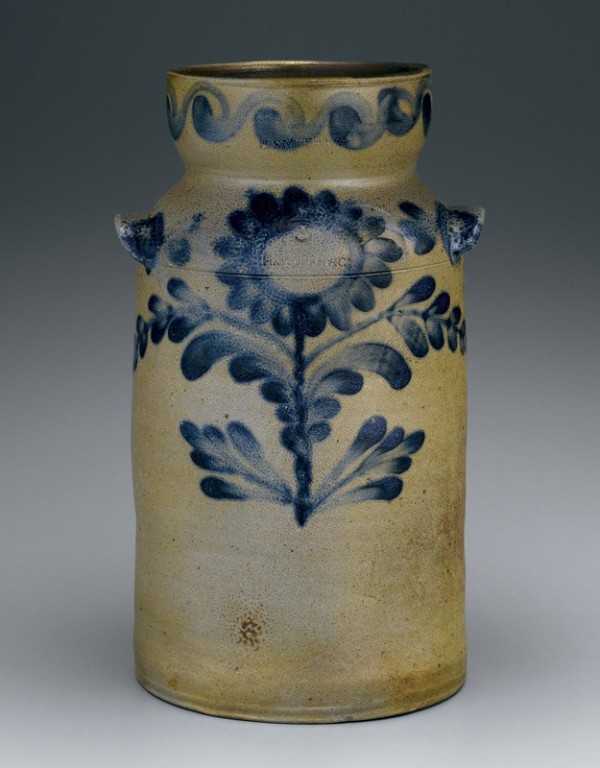
Churn, Alexandria, Virginia, 1826–1831. Salt-glazed stoneware. H. 15 3/4". Capacity: 3 gallons. Impressed “H.SMITH & CO.” (Courtesy, William and Jane Yeingst.) This churn combines elements of the other vessels decorated in the Jarbour style. The design on the neck is also seen on the reverse of a jar from this period (see fig. 30).

Jar, Alexandria, Virginia, 1825–1831. Salt-glazed stoneware. H. 15 1/2". Capacity: 2 gallons. Impressed “H.SMITH & CO.” (Courtesy, Alan Darby.)
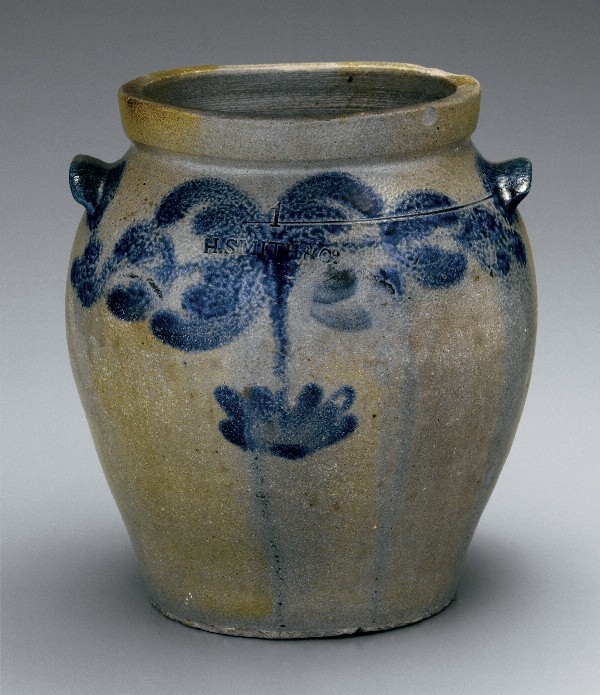
Jar, Alexandria, Virginia, 1825–1831. Salt-glazed stoneware. H. 8 1/2". Capacity: 1 gallon. Impressed “H.SMITH & CO.” (Courtesy, Al Marzorini.)
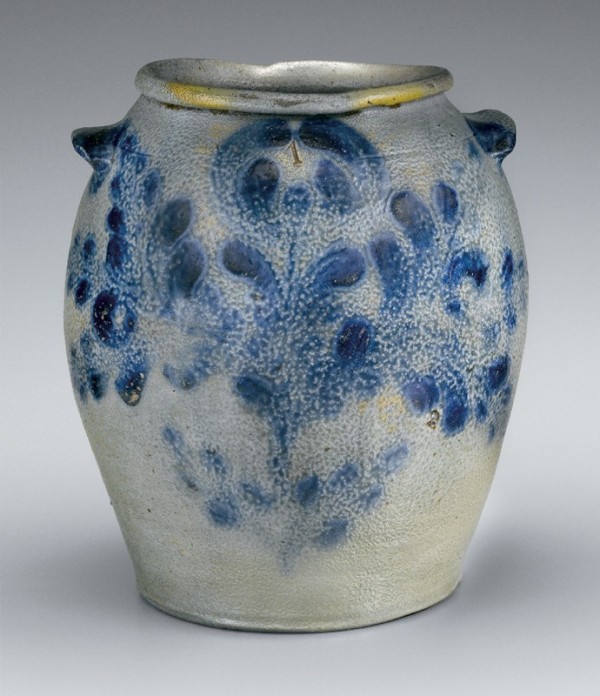
Jar, Alexandria, Virginia, 1825–1831. Salt-glazed stoneware. H. 9". (Courtesy, Toby and Oscar Fitzgerald.) While most Alexandria vessels were marked, a few unmarked pieces can be attributed to the Wilke Street Pottery based on form and decoration. The diagonal branches extending from the base and the foliate elements on this piece are similar to other jars of the “H.SMITH & CO.” period.

Jar, David Jarbour, Alexandria, Virginia, 1830. Salt-glazed stoneware. H. 27 3/4", D. 11 1/2". (Courtesy, Museum of Early Southern Decorative Arts.) This exceptionally large pot is the only signed and dated vessel known from Alexandria and may have marked a significant achievement in Jarbour’s career.

Detail of the base of the jar illustrated in fig. 42. Signed in script on base: “1830 / Alexa / Maid by / D. Jarbour.”
